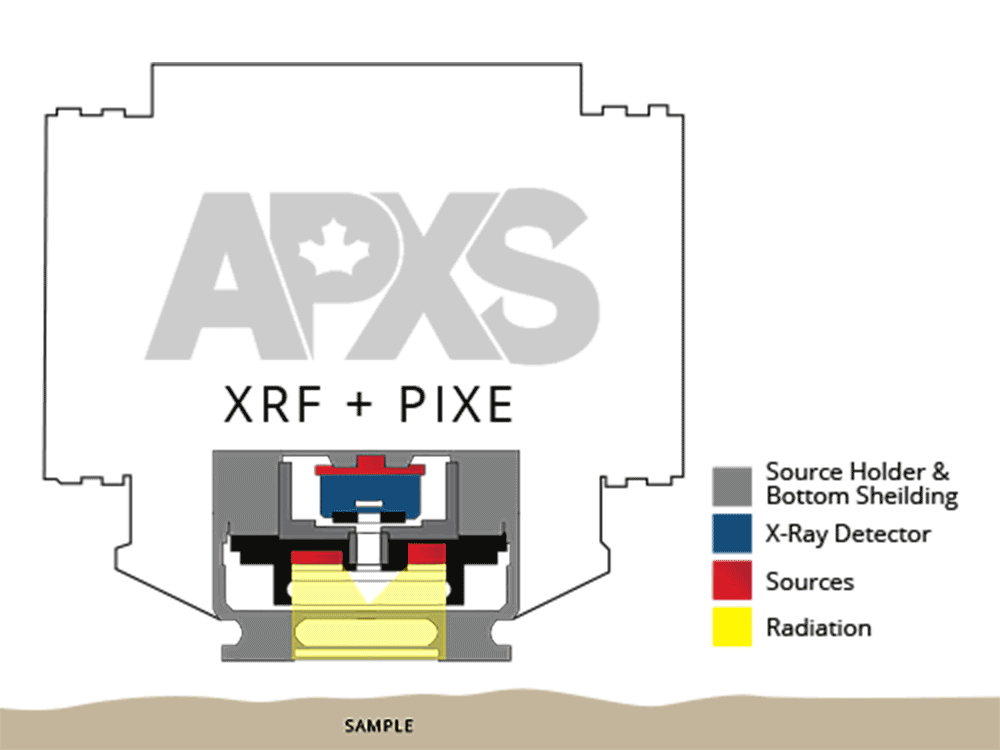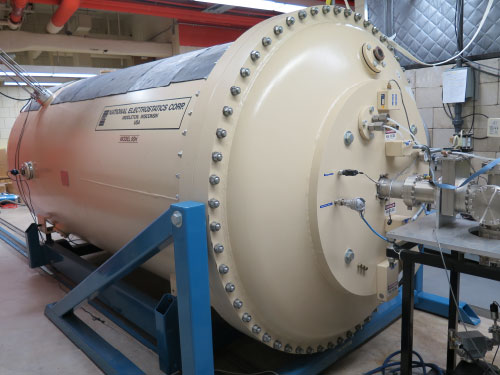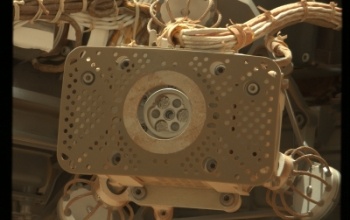APXS SCIENCE
The APXS (Alpha Particle X-ray Spectrometer) uses the science of XRF (X-Ray Fluorescence) and PIXE (Particle-Induced X-ray Emission) to determine elemental composition of rocks and soils found by Curiosity on Mars. These techniques work by ‘illuminating’ a target with radiation and exciting the atoms within. Once excited, the atoms in the target release X-rays of their own, which are unique for each element. By capturing these X-rays, measuring their energy, and counting them APXS scientists can determine not only which elements are present in the target, but how much of each one.
On Earth, these two techniques require separate and bulky laboratory equipment. This is especially true of PIXE which is typically done using a particle accelerator weighing several tonnes and occupying an entire room! To get these powerful techniques into outer space they needed to lose a lot of weight, and to do this the APXS employs an ingenious solution. To provide the X-rays and Alpha particles it requires for exciting atoms in Martian samples, the instrument relies on a small amount of carefully selected strongly radioactive material (a radioisotope called Curium-244). The tiny quantity of Curium in the APXS produces similar types of excitation radiation to both the accelerator and desktop devices used on Earth.
CARE AND CONTAINMENT
Curium is very dangerous, so extreme care and highly specialized nuclear containment facilities are required when working with it. Additionally, naturally radioactive materials tend to produce a range of radiation across multiple energies, rather than the “cleaner” well-defined single energies of Earthbound techniques, resulting in a reduction in data quality. Taken together, these compromises result in an instrument that is very light weight, can survive the rigours of launch, space flight, and landing on a distant planet, while still being able to produce precise and unambiguous data and consuming few resources.
A STORY FROM ELEMENTS
XRF and PIXE each specialize in a limited set of elements. PIXE is sensitive to lighter elements like those from sodium (Na) up to manganese (Mn), whereas XRF can ‘see’ heavier elements including those from iron (Fe) up to bromine (Br). The one-two punch of PIXE + XRF is ideal for space geology because it can give you a complete picture of all the elements present, from those generally present in large amounts like Silicon (Si) and Iron (Fe), to those present in smaller amounts like sodium (Na) or potassium (K), and even those present in tiny trace amounts, like nickel (Ni) or bromine (Br). With this complete picture geochemists can begin to piece together the story of the environments and processes that shaped the rocks we find and ultimately the whole planet.
 This is a caption
This is a caption
 This is a caption
This is a caption
 This is a caption
This is a caption
INSTRUMENT DESIGN
The APXS sensor head is the size of a can of pop. On the front face the six Curium-244 sources are arrayed in a circle around the X-ray detector. Since Curium-244 emits approximately 10X more alpha particles than X-rays, the APXS uses two different types of sources to balance them out; the “open” type, which can be recognized by their shiny Ti foil cover, allows both X-rays and alpha particles to escape from the Curium, while the “closed” type suppresses the alphas, allowing only the X-rays through. This clever design balances the PIXE and XRF techniques to optimize the science data.
Connected to the sensor head via a very long (11 metres!) cable that snakes through the rover arm and into its body, is the MEU (Main Electronics Unit). The signals produced by the detector in the sensor head are transmitted back to the MEU for analysis and counting. The MEU also generates the high voltages and control signals that power the sensor head. Each X-ray that interacts with the detector produces an electronic pulse whose height is proportional to the X-ray energy. The electronics in the MEU measure the pulse height to determine the energy, and then increment a counter corresponding to that energy reading. The resulting list of energies and counts is called a spectrum, and is generally shown as a histogram-like plot. Each spike in the plot corresponds to a large number of X-rays at the given energy measured, which in turn corresponds to the presence (and abundance) of a particular element in the sample.
Making an APXS measurement requires moving the rover arm to place APXS in close proximity to a given target. As soon as the sensor head is close to the target we can begin our measurement. The instrument is powered on and the electronics are engaged to begin registering and counting the X-ray pulses from the detector. A picture of the major elements in the sample begins to reveal itself within a minute or two, but for precise measurements of elements present in smaller quantities we may continue acquiring data for as long as several hours. Often the instrument runs overnight to get a high quality data set.


